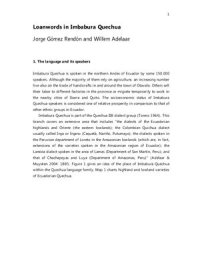
Ebook: Loanwords in Imbabura Quechua
Author: Gómez Rendón J.A. Adelaar W.
- Genre: Linguistics // Foreign
- Tags: Языки и языкознание, Языки индейцев, Кечуа
- Language: Indigenous-English
- pdf
Статья опубликована в сборнике Loanwords in the world's languages: a comparative handbook. M. Haspelmath & U. Tadmor (Eds.). — Berlin: De Gruyter Mouton, 2009. — PP. 944-967.Imbabura Quechua is spoken in the northern Andes of Ecuador by some 150.000 speakers. Although the majority of them rely on agriculture, an increasing number live also on the trade of handicrafts in and around the town of Otavalo. Others sell their labor to different factories in the province or migrate temporarily to work in the nearby cities of Ibarra and Quito. The socioeconomic status of Imbabura Quechua speakers is considered one of relative prosperity in comparison to that of other ethnic groups in Ecuador. Imbabura Quechua is part of the Quechua IIB dialect group (Torero 1964). This branch covers an extensive area that includes the dialects of the Ecuadorian highlands and
Oriente (the eastern lowlands); the Colombian Quichua dialect usually called Inga or Ingano
(Caquetá, Nariño, Putumayo); the dialects spoken in the Peruvian department of Loreto in the Amazonian lowlands (which are, in fact, extensions of the varieties spoken in the Amazonian region of Ecuador); the Lamista dialect spoken in the area of Lamas (Department of San Martín, Peru); and that of Chachapoyas and Luya (Department of Amazonas, Peru) (Adelaar & Muysken 2004: 186f). Figure 1 gives an idea of the place of Imbabura Quechua within the Quechua language family. Map 1 charts highland and lowland varieties of Ecuadorian Quechua.
Oriente (the eastern lowlands); the Colombian Quichua dialect usually called Inga or Ingano
(Caquetá, Nariño, Putumayo); the dialects spoken in the Peruvian department of Loreto in the Amazonian lowlands (which are, in fact, extensions of the varieties spoken in the Amazonian region of Ecuador); the Lamista dialect spoken in the area of Lamas (Department of San Martín, Peru); and that of Chachapoyas and Luya (Department of Amazonas, Peru) (Adelaar & Muysken 2004: 186f). Figure 1 gives an idea of the place of Imbabura Quechua within the Quechua language family. Map 1 charts highland and lowland varieties of Ecuadorian Quechua.
Download the book Loanwords in Imbabura Quechua for free or read online
Continue reading on any device:

Last viewed books
Related books
{related-news}
Comments (0)